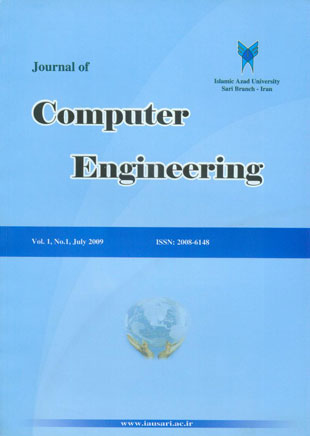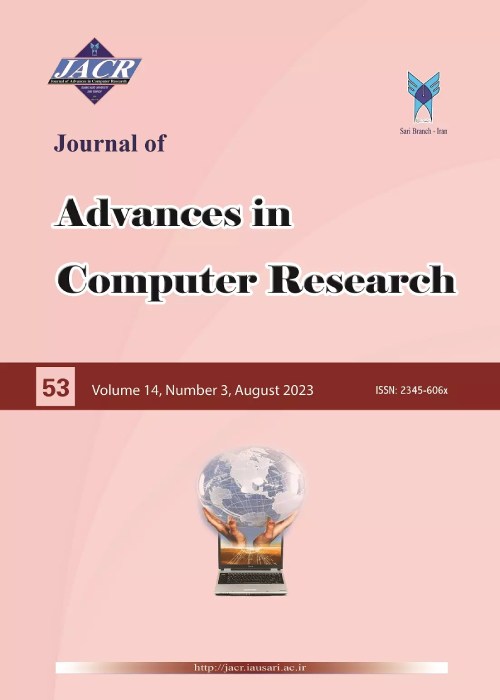فهرست مطالب

Journal of Advances in Computer Research
Volume:1 Issue: 1, Summer 2010
- 90 صفحه،
- تاریخ انتشار: 1389/12/20
- تعداد عناوین: 8
-
Pages 1-9Object detection plays an important role in successfulness of a wide range of applications that involve images as input data. In this paper we have presented a new approach for background modeling by nonconsecutive frames differencing. Direction and velocity of moving objects have been extracted in order to get an appropriate sequence of frames to perform frame subtraction. Stationary parts of background are extracted from differenced frames and joined as patches to complete the background model. There is also a special stage to handle changing regions of dynamic scenes. During the detection phase, the modeled background is updated for every new frame. Since it''s not necessary to estimate each pixel gray value like the most common statistical methods, modeling process is not time-consuming. Different experiments show successful results even for challenging phenomena like environmental changes.
-
Pages 11-18In analyzing a signal, especially a non-stationary signal, it is often necessary the desired signal to be segmented into small epochs. Segmentation can be performed by splitting the signal at time instances where signal amplitude or frequency change. In this paper, the signal is initially decomposed into signals with different frequency bands using wavelet transform. Then, fractal dimension of the decomposed signal is computed and used as a feature for adaptively segmenting the signal. Any changes on the signal amplitude or frequency are reflected on the fractal dimension of the signal. The proposed method was applied on a synthetic signal and real EEG to evaluate its performance on segmenting non-stationary signals. The results indicate that the proposed approach outperforms the existing method in signal segmentation.
-
Pages 19-27In many signal processing applications, an appropriate measure to compare two signals plays a fundamental role in both implementing the algorithm and evaluating its performance. Several techniques have been introduced in literature as similarity measures. However, the existing measures are often either impractical for some applications or they have unsatisfactory results in some other applications. This problem becomes more evident when signals involve translations in amplitude and time. This paper presents a new one dimensional similarity measure to compare two signals. The proposed measure accepts transformations like time-shift, amplitude-scale, amplitude-shift, and phase delay in measuring the similarity. The results in this paper indicate that the proposed approach overcomes exiting techniques in measuring similarity among different signals.
-
Pages 29-44UML is known as one of the most common methods in software engineering. Since this language is semi-formal, many researches and efforts have been performed to transform this language into formal methods including Petri nets. Thus, the operation of verification and validation of the qualitative and non-functional parameters could be achieved with more ability. Since the majority of the real world information is uncertain, therefore fuzzy UML diagram has been extensively used by system analyzers. This paper is an attempt to transform state diagrams created in fuzzy UML into fuzzy Petri net, so that the verification and performance evaluation operation could be performed formally, rather than exact visual analysis.
-
Pages 45-52In many active noise control (ANC) applications, an online secondary path modelling method that uses a white noise as a training signal is required. This paper proposes a new feedback ANC system. Here we modified both the FxLMS and the VSS-LMS algorithms to raised noise attenuation and modelling accuracy for the overall system. The proposed algorithm stops injection of the white noise at the optimum point and reactivate the injection during the operation, if needed, to maintain performance of the system. Preventing continuous injection of the white noise increases the performance of the proposed method significantly and makes it more desirable for practical ANC systems. Computer simulation results shown in this paper indicate effectiveness of the proposed method.
-
Pages 53-59This article presents a new subspace-based technique for reducing the noise of signals in time-series. In the proposed approach, the signal is initially represented as a data matrix. Then using Singular Value Decomposition (SVD), noisy data matrix is divided into signal subspace and noise subspace. In this subspace division, each derivative of the singular values with respect to rank order is used to reduce the effect of space intersections on altering the structure of important information in the signal. On the other hand, since singular vectors are the span bases of the matrix, reducing the effect of noise from the singular vectors and using them in reproducing the matrix, enhances the information embedded in the matrix. The proposed technique utilizes the Savitzky-Golay low-pass filter for noise attenuation from the singular vectors. The enhanced matrix is finally transformed to a time-series signal. The obtained results in this research indicate that the proposed method excels the other existing time-domain approaches in noise reduction.
-
Pages 61-75Obviously navigation is one of the most complicated issues in mobile robots. Intelligent algorithms are often used for error handling in robot navigation. This Paper deals with the problem of Inertial Measurement Unit (IMU) error handling by using Extended Kalman Filter (EKF) as an Expert Algorithms. Our focus is put on the field of mobile robot navigation in the 2D environments. The main challenge in this issue is to keep track of the position and orientation within a global frame of reference using a variety of sensors providing Dead-Reckoned Odometry, Inertial and Absolute data.
-
Pages 77-88Blind source separation technique separates mixed signals blindly without any information on the mixing system. In this paper, we have used two evolutionary algorithms, namely, genetic algorithm and particle swarm optimization for blind source separation. In these techniques a novel fitness function that is based on the mutual information and high order statistics is proposed. In order to evaluate and compare the performance of these methods, we have focused on separation of noisy and noiseless sources. Simulations results demonstrate that proposed method for employing fitness function have rapid convergence, simplicity and a more favorable signal to noise ratio for separation tasks based on particle swarm optimization and continuous genetic algorithm than binary genetic algorithm. Also, particle swarm optimization enjoys shorter computation time than the other two algorithms for solving these optimization problems for multiple sources.


